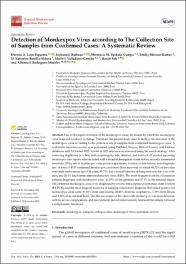Mostrar el registro sencillo del ítem
Detection of Monkeypox Virus according to The Collection Site of Samples from Confirmed Cases: A Systematic Review
| dc.contributor.author | León-Figueroa, Darwin A. | |
| dc.contributor.author | Barboza, Joshuan J. | |
| dc.contributor.author | Saldaña-Cumpa, Hortencia M. | |
| dc.contributor.author | Moreno-Ramos, Emilly | |
| dc.contributor.author | Bonilla-Aldana, D. Katterine | |
| dc.contributor.author | Valladares-Garrido, Mario J. | |
| dc.contributor.author | Sah, Ranjit | |
| dc.contributor.author | Rodriguez-Morales, Alfonso J. | |
| dc.date.accessioned | 2023-05-29T14:06:14Z | |
| dc.date.available | 2023-05-29T14:06:14Z | |
| dc.date.issued | 2022-12-22 | |
| dc.identifier.uri | https://hdl.handle.net/20.500.13053/8628 | |
| dc.description.abstract | Due to the rapid evolution of the monkeypox virus, the means by which the monkeypox virus is spread is subject to change. Therefore, the present study aims to analyze the detection of the monkeypox virus according to the collection site of samples from confirmed monkeypox cases. A systematic literature review was performed using PubMed, Scopus, Web of Science, and Embase databases until 5 October 2022. A total of 1022 articles were retrieved using the search strategy. After removing duplicates (n = 566) and examining by title, abstract, and full text, 65 studies reporting monkeypox case reports were included with a detailed description of risk factors, sexually transmitted infections (STIs), site of monkeypox virus-positive specimens, location of skin lesions, and diagnostic test. A total of 4537 confirmed monkeypox cases have been reported, of which 98.72% of the cases were male with a mean age of 36 years, 95.72% had a sexual behavior of being men who have sex with men, and 28.1% had human immunodeficiency virus (HIV). The most frequent locations of lesions in patients diagnosed with monkeypox were: 42.85% on the genitalia and 37.1% in the perianal region. All confirmed monkeypox cases were diagnosed by reverse transcriptase polymerase chain reaction (RT-PCR), and the most frequent locations of samples collected for diagnosis that tested positive for monkeypox virus were: 91.85% from skin lesions, 20.81% from the oropharynx, 3.19% from blood, and 2.43% from seminal fluid. The disease course of the cases with monkeypox was asynchronous, with no severe complications, and most patients did not report specific treatment but simply followed a symptomatic treatment. | es_PE |
| dc.format | application/pdf | es_PE |
| dc.language.iso | eng | es_PE |
| dc.publisher | MDPI | es_PE |
| dc.rights | info:eu-repo/semantics/openAccess | es_PE |
| dc.rights.uri | https://creativecommons.org/licenses/by/4.0/ | es_PE |
| dc.subject | monkeypox; samples; orthopoxvirus; monkeypox virus; systematic review | es_PE |
| dc.title | Detection of Monkeypox Virus according to The Collection Site of Samples from Confirmed Cases: A Systematic Review | es_PE |
| dc.type | info:eu-repo/semantics/article | es_PE |
| dc.identifier.doi | https://doi.org/10.3390/tropicalmed8010004 | |
| dc.type.version | info:eu-repo/semantics/publishedVersion | es_PE |
| dc.publisher.country | CH | es_PE |
| dc.subject.ocde | 3.00.00 -- Ciencias médicas, Ciencias de la salud | es_PE |
Ficheros en el ítem
Este ítem aparece en la(s) siguiente(s) colección(es)
-
Web of Science (WOS) [236]


